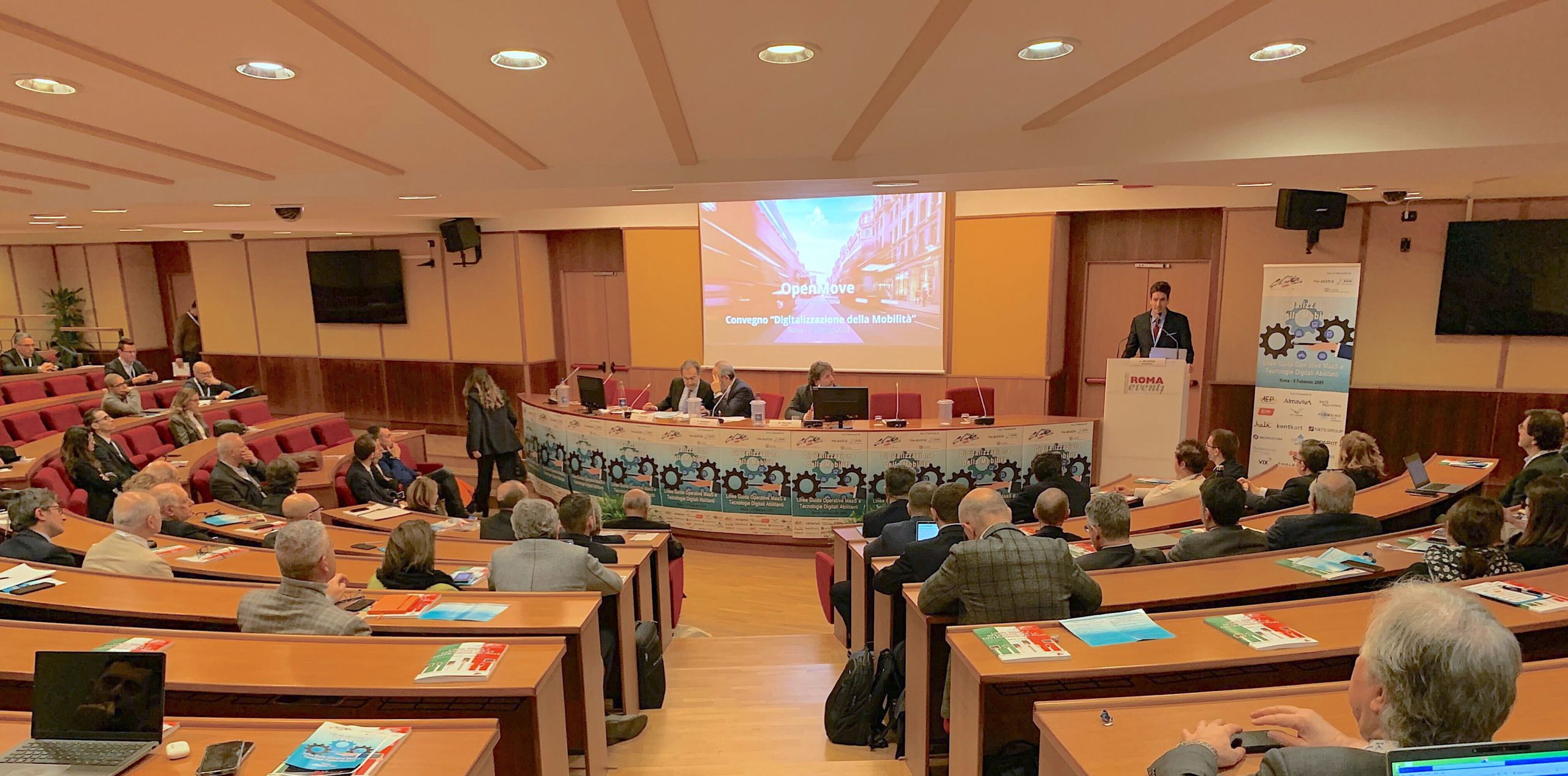On the occasion of the conference on “Digitization of Mobility” held in Rome on February 9, 2023, OpenMove was invited to share its experience in delivering MaaS projects. It was an opportunity for us to highlight some aspects that may seem unrelated to MaaS, but which are actually essential for successful implementation and management.
We therefore presented 6 MaaS-related issues, from different points of view and degrees of depth, aware that there is still much work to do on the matter together with all the conference participants.
1. ACCOUNT-BASED TICKETING
Account-Based Ticketing (ABT) is, without a doubt, the necessary ticketing method in order to do MaaS: there can be no MaaS without ABT. Indeed, the ABT represents the foundation of MaaS, being the only solution capable of guaranteeing scalability, versatility, accessibility and interoperability between transport services and the MaaS ecosystem. These are all words that – not surprisingly – rhyme with mobility.
And what is the real ABT like? The ISO/TR 20526: 2017 clarifies it (and we talk about it ourselves in this blog post):
- The ABT is a ticketing method where the proof of the right to travel and all the travel records are contained in the back office and not in the physical media (“media”) held by the passenger (we also explain it here).
- The intelligence and security of the ticketing system are concentrated in the central system rather than in the media and related readers.
- The ABT can work both online and offline (often referred to as “degraded mode”) using risk-managed revenue protection techniques.
MaaS and ABT are intimately linked: at OpenMove, we are so deeply convinced that – at an architectural, technological and operational level – we have actually developed a single technology platform to deliver our MaaS and ABT projects, and not two separate systems!
In parallel, we understood the importance of doing MaaS by mastering the ITS systems (Intelligent Transport Systems) of the transport services on which it lies, and vice versa the need to implement ticketing systems knowing the world of MaaS and directing them to it.
2. BLUETOOTH VALIDATION
MaaS is meant to facilitate the User Experience (UX) of passengers: therefore we cannot fail to focus on the importance of validation, the act through which the user is welcomed into public transport. Our experience has shown us that the Bluetooth validation – which is an expression of ABT ticketing – considerably facilitates and speeds up the access to the vehicle.
Bluetooth validation can basically be done in two ways:
- Modifying the on-board control units;
- By installing small and inexpensive devices – called beacons – capable of emitting the Bluetooth signal, on the vehicle or at the stop.
OpenMove was lucky enough to gather experience with projects of both types, in Trentino and Sardinia, the first two examples on a regional scale in Italy and among the first in Europe. The two approaches have advantages and disadvantages depending on the context (we talk about it in this blog post and we are always available to delve into it), and a hybrid approach is also possible.
A final aspect that deserves to be mentioned is the distinction between Check-in and Be-in: while in the first case the user performs a voluntary validation action, in the second case the process is automated. It is a radical paradigm shift not only for users, but also for transport operators.
Which is better? It depends on the fare schemes, user experience, fleet tracking and other variables. It can be complex, in fact these are just some of the aspects to be addressed before implementing a Bluetooth validation project that can also positively involve MaaS Operators.
3. ADAPTIVE MAAS
There is no universal MaaS and, to prove it, we bring two antipodal examples on which we are working. On the one hand, the so-called “Giga projects” in Saudi Arabia, in which mobility plays a crucial role, where the tender specifications envisage the integration of the so-called Urban Air Mobility (UAM) – i.e. moving through autonomous drones – while, at the opposite extreme, the MaaS project in which we are involved in Delhi in India, where the most used mode of transport is the rickshaw. In between there is Italy, with its thousand shades, from ski bus in Trentino to bike sharing that we are integrating for the MaaS solution of Senigallia, from ferries of Venice for the MaaS project in Veneto, to the airport shuttles that we integrated for the MaaS in Milan.

What have we learned?
- MaaS cannot disregard the needs analysis of people and the context, avoiding top-down solutions, but rather enhancing the specificity of the territories.
- The importance of real intermodality: transport services in a modern perspective are no longer competitors, yet complement each other.
- The common denominator is local public transport: you can’t do MaaS without public transport!
Which operators – public or private – fit into MaaS? Both. OpenMove has several private customers, who are looking for quality, reliability and effectiveness in the solutions; we have been offering them Automated Fare Collection systems (AFC) for years and nowadays we appreciate they are interested in joining the MaaS ecosystem.
4. DEMAND-RESPONSIVE TRANSPORT (DRT)
What is the relationship between DRT and MaaS? In the US, MaaS is de facto synonymous with MoD (Mobility on-Demand) and, in fact, the very definition of MaaS by the MaaS Alliance speaks of “accessible on-demand mobility service”.
The DRT (Demand-Responsive Transport), which is discussed in detail in this blog post, is perfect as feeder of the transport network and is particularly suitable as a first and last-mile service, in geographical areas with low demand and during non-busy times of the day; it has an impact on all users and in particular on tourists and the disabled.
There are diverse typologies of DRT services that can be implemented, which differ in one or more aspects:
- While the point-to-point scenario takes advantage of the local public transport stops and allows you to rationalize the collection, the door-to-door scenario on the other hand, gives total flexibility to the ridership.
- Thanks to modern route planning algorithms, it is possible to implement the so-called pooling, that is the sharing of the entire journey or of a specific leg among several passengers, with the aim of making the provision of the service more efficient.
- The vehicle capacity can vary a lot: from 9-seater mini buses, optimal for urban routes to complement the scheduled offer, up to standard-sized buses for routes to points of interest that catalyze a robust mass of tourists.
These are all variables and it is essential that they are treated as such: it must be possible to tailor the mobility offer on the actual demand which is constantly evolving.
Today there are two ways to make DRT, that are:
- Silo solution with completely separate technology
- Technological solution interoperable with fixed line transport
Unfortunately, most of the projects in Italy are silo solutions, with 2 user apps and 2 separate management platforms, with the problems – illustrated in this blog post – which this approach inevitably entails: operators which choose this path lose forever the possibility of doing MaaS. A well done DRT starts from MaaS: a MaaS platform must encompass fixed line transport, reservation services and on-demand transport, respecting an holistic view in the management of the various mobility schemes and of the different stakeholders.

5. INCLUSION
MaaS is often only within the reach of those who are digitalized: how to create a MaaS for everyone? There are different segments of the population that deserve particular attention to be welcomed in the MaaS ecosystem:
- Disabled people can – and must – be included thanks to measures on various levels:
-
- technological accessibility, thanks to the development of apps compliant with the Guidelines WCAG 2.1 relating to the accessibility of digital contents;
- quality of mobility services, for example by implementing a door-to-door on-demand transport service with the transport of wheelchairs and ensuring that the algorithm considers the increased loading and unloading time;
- adequate customer support: it is of great importance for MaaS providers to have customer care 7 days a week also for the end users (and so we did in OpenMove).
- The elderly, the so-called “unbanked” (i.e. those who do not have bank accounts and online payment instruments), and all those who are not sufficiently familiar with technology. If on the one hand the smartphone is a fundamental channel for two-way communication with the ridership, in order to achieve extensive capillarity a modern mobility scheme must be the multichannel. OpenMove, born several years ago with a mobile-first approach, at present includes in its MaaS and ABT projects the solutions for field staff, ticket offices and third-party resellers.
- Tourists, for whom the passenger information is essential to build the necessary trust in a local public transport system that they are unfamiliar with. We must remember that people always travel twice – the first time when they plan a trip and the second time when they make it – and the public transport is often not attractive when it comes to the first trip. In Trentino, an area where we have implemented a number of smart mobility solutions, that we present here, the most interesting data is perhaps not the fact that 9 out of 10 university students travel using a completely dematerialized free circulation pass, but that 3 out of 4 tourists move exclusively using the multimodal mobility app.
6. MAAS ARCHITECTURE
Years after the creation of this paradigm, is there still a need to work on the MaaS architecture? The answer is yes.
All the stakeholders working on MaaS have recognized how fundamental the identification of MaaS Operator and MaaS Integrator really is, roles that were introduced by European studies and clarified by the first MaaS experimental projects. Clarify the importance of the MaaS Integrator is crucial to implement projects, it helps the MaaS Operators themselves and ultimately allows them to unleash the true potential of MaaS – e.g.: effective governance of mobility, plurality of choice for the ridership, possibility of promoting modal shift – and allows for effective competition between the various suppliers of technology, to the benefit of the community.
Mobility is a precious asset for travelers and the old perspective needs to be reversed: we need systems that live and evolve, that are always operational and never become obsolete or abandoned at the end of the funding.
Experience teaches us that it is essential that the technical supplier works in partnership with transport operators and mature co-responsibility, deploying the best resources to ensure:
- service continuity
- incremental updates
- new features
- compatibility with the changing world
Among the biggest MaaS barriers there is usually the hardware, for example turnstiles that don’t open, validators which do not read the new media, AVM systems which do not communicate. A further change of perspective is represented by the so-called “hardware agnosticism” or hardware independence. Historically, the supplies of ITS systems have been driven by hardware, which involved:
- vendor lock-in, i.e. vendor dependency
- early obsolescence
- impossibility of integration
The hardware-agnostic approach – which we describe in this blog post – instead allows you to:
- always choose the best solution
- be open to MaaS
- save on purchase and maintenance costs
The MaaS brings the software to the center of everything. OpenMove has been on the market for 8 years and this approach initially aroused skepticism, then growing interest and now total approval by our customers, not just by private operators (such as the Arriva Italia group) but also public institutions (like the Region of Sardinia)!

The 6 aspects that we have covered narrate the MaaS from different perspectives and cover issues that in many cases are still open.
We are glad, as OpenMove, to continue to tell our experience and to continue this journey together with our customers and partners.


